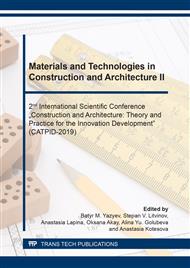[1]
V.A. Bezborodov [et al.], Dry mixes in modern construction, Novosibirsk, (1998).
Google Scholar
[2]
P.I. Meshkov, V.A. Mokin, From Hartsovka - to modified dry mixtures, Construction materials. 3 (1999) 34-36.
Google Scholar
[3]
V.I. Korneev, P.V. Zozulya, Dry mortars (composition, properties), RIF Building Materials,, Moscow, (2010).
Google Scholar
[4]
E.A. Shamenskaya, T.N. Orlova, Tiled dry adhesives and systems, Construction materials. 7 (8) (1999) 14-16.
Google Scholar
[5]
M.I. Khaliullin, Modern adhesive dry mortars using a complex of local mineral additives, News of KazGASU. 1 (9) (2008) 131-136.
Google Scholar
[6]
Yu.V. Puharenko, A.M. Kharitonov, N.N. Shangina, T.Yu. Safonova, Restoration of historical objects using modern dry mortars, Bulletin of civil engineers. 1 (26) (2011) 98-103.
Google Scholar
[7]
R. Zyurbriggen, P. Dilger, Dispersion polymer powders - behavioral peculiarities in dry mortars, Construction materials. 3 (1999) 10-13.
Google Scholar
[8]
A.E. Zakhezin, T.N. Chernykh, B.Ya. Trofimov, L.Ya. Kraram, The influence of re-dispersible powders on the properties of cement mortars, Construction materials. 10 (2004) 6-8.
Google Scholar
[9]
S.A. Golunov, Modification of tile adhesives with re-dispersible polymeric powders VINNAPAS, Construction materials. 3 (2004) 47-50.
Google Scholar
[10]
G.V. Nesvetaev, Concretes: a reference manual. 2nd edPhoenix, Rostov-on-Don, (2013).
Google Scholar
[11]
G.V. Nesvetaev, О.K. Bazoev, New series of concrete additives produced by NPP Irstroyprogress, Concrete and reinforced concrete in the third millennium: Proceedings of the 4th int. conf. Rostov-on-Don: RSSU. (2006) 319-326.
Google Scholar
[12]
O.A. Bychkova, Glue of fast fixing on the basis of gypsum-aluminous expanding cement and Portland cement, Don Engineering Newsletter (electronic scientific journal). 3 (2018). Information on http:// ivdon.ru/ru/magazine/archive/n3y2018/5102.
Google Scholar
[13]
O.A. Bychkova, Quick-hardening screeds based on gypsum-alumina expanding cement and Portland cement, Don Engineering Newsletter (electronic scientific journal). 3 (2018). Information on http:// ivdon.ru/ru/magazine/archive/n3y2018/5103.
Google Scholar
[14]
A.V. Kovalenko, Influence of modifying additives on the properties of repair and protective mixtures, Collection of scientific works of SWorld. 1 (38) (6) (2015) 95-101.
Google Scholar
[15]
The use of modifiers to control the modulus of elasticity of concrete, New scientific directions of building materials science: Academic readings of the RAACS, Belgorod. 2 (2005) 51-57.
Google Scholar
[16]
G.V. Nesvetaev, M.A. Uzhakhov, Some issues of quality assessment of tile adhesives, ALITinform: Cement. Concrete. Dry Mixes. 1 64-66.
Google Scholar
[17]
Y. Ohama, Handbook of polymer-modified concrete and mortars. Noyes Publications, Japan, (1995).
Google Scholar
[18]
S. Rajgelj, Cohesion aspects in rheological behavior of fresh cement mortars, Mater. et constr. 104 (1985) 109-114.
DOI: 10.1007/bf02473377
Google Scholar


